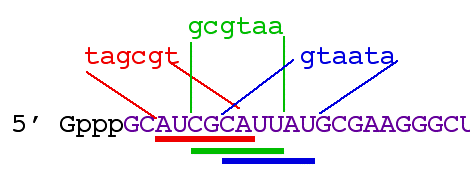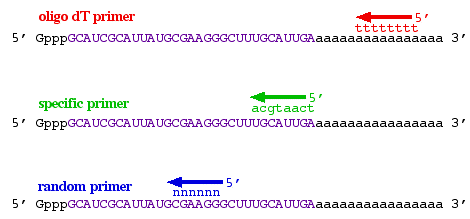A primer is a short synthetic oligonucleotide which is used in many molecular techniques from PCR to DNA sequencing. These primers are designed to have a sequence which is the reverse complement of a region of template or target DNA to which we wish the primer to anneal.
Reference: What is a primer
2. What is a random primer??
Random primers are short segments of single-stranded DNA (ssDNA)
called oligonucleotides, or oligos for short. These
oligos are only 8 nucleotides long (octamers) and they consist of every
possible combination of bases which means there must be 48 =
65,536 different combinations in the mixture. Because every possible
hexamer is present, these primers can bind to any section of DNA.Reference: random primer
3. More about primer
The only issue worth mentioning now is that three different types of primers can be used (figure 3). 1)
- If the mRNA has a poly-A 3' tail, then an oligo-dT primer can be used to prime all mRNAs simultaneously. 2)
- If you only wanted to produce cDNA from a subset of all mRNA, then a sequence-specific primer could be used that wil only bind to one mRNA sequence. 3)
- If you wanted to produce pieces of cDNA that were scattered all over the mRNA, then you could use a random primer cocktail that would produce cDNA from all mRNAs but the cDNAs would not be full length.
The major benefits to random priming are the production of shorter cDNA fragments and increasing the probability that 5' ends of the mRNA would be converted to cDNA. Because reverse transcriptase does not usually reach the 5' end of long mRNAs, random primers can be beneficial
Reference: primer and CDNA


沒有留言:
張貼留言